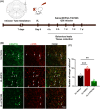mGluR1/IP3/ERK signaling pathway regulates vestibular compensation in ON UBCs of the cerebellar flocculus
- PMID: 37622292
- PMCID: PMC10848063
- DOI: 10.1111/cns.14419
mGluR1/IP3/ERK signaling pathway regulates vestibular compensation in ON UBCs of the cerebellar flocculus
Abstract
Aims: To investigate the role of mGluR1α in cerebellar unipolar brush cells (UBC) in mediating vestibular compensation (VC), using mGluR1α agonist and antagonist to modulate ON UBC neurons, and explore the mGluR1/IP3/extracellular signal-regulated kinase (ERK) signaling pathway.
Methods: First, AAV virus that knockdown ON UBC (mGluR1α) were injected into cerebellar UBC by stereotactic, and verified by immunofluorescence and western blot. The effect on VC was evaluated after unilateral labyrinthectomy (UL). Second, saline, (RS)-3,5-dihydroxyphenylglycine (DHPG), and LY367385 were injected into tubes implanted in rats at different time points after UL separately. The effect on ON UBC neuron activity was evaluated by immunofluorescence. Then, Phosphoinositide (PI) and p-ERK1/2 levels of mGluR1α were analyzed by ELISA after UL. The protein levels of p-ERK and total ERK were verified by western blot. In addition, the effect of mGluR1α activation or inhibition on VC-related behavior was observed.
Results: mGluR1α knockdown induced VC phenotypes. DHPG increased ON UBC activity, while LY367385 reduced ON UBC activity. DHPG group showed an increase in PI and p-ERK1/2 levels, while LY367385 group showed a decrease in PI and p-ERK1/2 levels in cerebellar UBC of rats. The western blot results of p-ERK and total ERK confirm and support the observations. DHPG alleviated VC-related behavior phenotypes, while LY367385 exacerbated vestibular decompensation-like behavior induced by UL.
Conclusion: mGluR1α activity in cerebellar ON UBC is crucial for mediating VC through the mGluR1/IP3/ERK signaling pathway, which affects ON UBC neuron activity and contributes to the pathogenesis of VC.
Keywords: mGluR1α; unipolar brush cells; vestibular compensation.
© 2023 The Authors. CNS Neuroscience & Therapeutics published by John Wiley & Sons Ltd.
Conflict of interest statement
The authors declare no conflict of interest.
Figures






References
-
- Barmack NH, Baughman RW, Errico P, Shojaku H. Vestibular primary afferent projection to the cerebellum of the rabbit. J Comp Neurol. 1993;327(4):521‐534. - PubMed
-
- Barmack NH, Baughman RW, Eckenstein FP, Shojaku H. Secondary vestibular cholinergic projection to the cerebellum of rabbit and rat as revealed by choline acetyltransferase immunohistochemistry, retrograde and orthograde tracers. J Comp Neurol. 1992;317(3):250‐270. - PubMed
Publication types
MeSH terms
Substances
Grants and funding
LinkOut - more resources
Full Text Sources
Molecular Biology Databases
Research Materials
Miscellaneous

